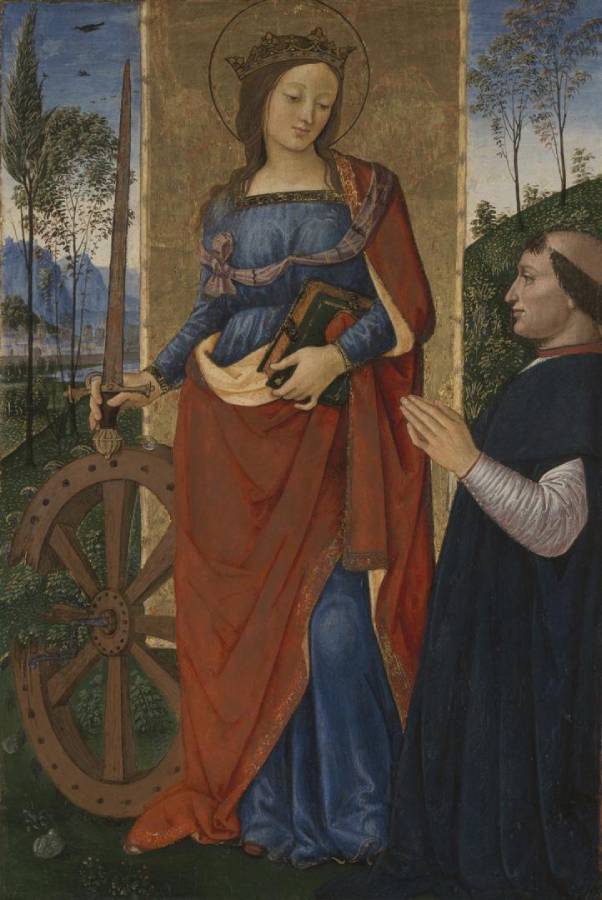Pinturicchio (c.1454-1513)
Santa Caterina d’Alessandria e committente (Saint Catherine of Alexandria with a Donor)
c.1480
Oil on wood, 56.5 x 38.1 cm
National Gallery, London
This painting was made for private worship, and the donor who commissioned it is shown kneeling in prayer towards the majestic figure of Saint Catherine. Catherine, shown wearing a crown, was a princess from Alexandria. According to the Golden Legend, she was persecuted by Roman Emperor Maxentius for her Christian faith, though she eventually converted him. Behind her is the spiked wheel that she was tied to in an attempt to kill her, a torture she miraculously survived. The sword is a reminder of her eventual beheading.
The donor’s tonsure (partly shaved hair) shows that he was a cleric. It’s possible that he worked for Pope Alexander VI: his robes here were painted with a mixture of red and blue pigments (specifically red lake and azurite) to create a lilac or purple hue, a colour worn by those who held an official post in the papal court. Pope Alexander was particularly devoted to Saint Catherine, and she features prominently in the Vatican apartments decorated for him at around the time this panel was made. The patron, then, might have been showing his loyalty to the pope through this image. He may be Jacopo Pesaro, Bishop of Paphos in Cyprus: his features resemble the profile view of Pesaro in a painting Titian made in 1502 (Royal Museum of Fine Arts, Antwerp), which shows him being presented to Pope Alexander VI. It was Alexander who made Pesaro bishop in 1495 and our picture may commemorate that event.
Catherine is shown against a gold banner painted in minute detail, which highlights her divinity by separating her from the landscape background. If you look closely you can see individual buildings in the town beyond the river – and even some on top of the enormous mountains which loom above it. They appear blue and hazy to give the impression that they are a long way away, a technique called aerial perspective made famous by Leonardo.
The picture was once thought to be painted by an associate of Pintoricchio – a member of his workshop – but after it was cleaned in 2008 its true quality was revealed. Pintoricchio used a variety of methods of applying gold leaf to enrich the decoration. The upper part of the picture is painted over gold leaf, and paint has been scratched away in places so that the leaves of the trees appear to reflect a golden sunlight – a technique called sgraffito. The decoration of Catherine’s robe has been applied using mordant (an oil-based adhesive) to fix the gold leaf over painted areas. Her sword once gleamed with silver leaf which has now degraded. (NG)
See also:
• Borgia, Rodrigo (1431-1503), Pope Alexander VI (1492-1503)
